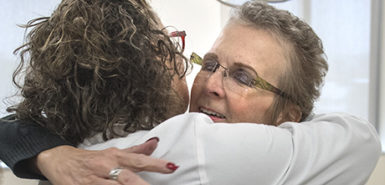
It’s been said that the doctor knows best.
Teri Sullivan, a 74-year-old from Ludington, knows firsthand how a doctor’s advice can save your life.
In summer 2014, she had a routine appointment with her primary care physician, who suggested she get a mammogram at Spectrum Health Ludington Hospital’s Women’s Imaging Center.
But Sullivan felt skeptical. She’d heard that mammograms could be done less frequently.
“I hesitated because I had heard that mammograms weren’t as essential as he was suggesting,” she said.
The American Cancer Society, for instance, has suggested women should begin yearly mammograms at age 45 and then get one every other year starting at age of 55.
But some accrediting organizations and physicians, including Sullivan’s, continue to recommend the more stringent guidelines, which encourage annual mammograms starting at age 40.
“Patients should speak to their physician about how often they should have a mammogram,” said Ann Koss, DO, lead radiologist at Spectrum Health Ludington Hospital. “In general, radiologists follow guidelines set by the American College of Radiology that recommend mammograms beginning at age 40 in normal-risk women, and even earlier in those who are high-risk. Early breast cancer detection reduces deaths, extends life expectancy and improves quality of life.”
‘They are family’
Despite her hesitations, Sullivan agreed to have a mammogram.
As it turns out, her doctor’s recommendation may have saved her life.
“They found an abnormality in my left breast,” she said. Doctors diagnosed it as breast cancer. “Had I not followed my doctor’s recommendation to get a mammogram, my cancer may not have been caught for another year or more. The prognosis could have been a lot different if I would’ve waited.”
She soon found herself particularly impressed by the staff at the Women’s Imaging Center.
“It was really wonderful being there,” she said. “There was a technologist who let me hold her hand while they were doing the biopsy. Another technologist assisted the radiologist with the procedure. They were so kind that it helped take away some of the harshness of the procedure.”
Since her original cancer diagnosis, Sullivan has continued to visit the Women’s Imaging Center for regular mammograms.
“It’s like a party when I go back to the Women’s Imaging Center,” she said. “I feel like they are family because they are all so wonderful.”
The Women’s Imaging Center is one of the centerpieces of Spectrum Health Ludington Hospital. Opened in 2009, the center was completely funded by more than $1 million in private donations.
“It certainly is an asset to our community,” Sullivan said. “And for a community our size, we are extremely lucky to have it.”
Investing in women’s health
Digital mammography helped doctors discover Sullivan’s breast cancer. Considered state-of-the-art at its introduction to Spectrum Health Ludington Hospital in 2009, digital mammography technology has since advanced to a 3-D version that can provide better images, quicker diagnosis and fewer callbacks.
“We are excited to offer 3-D mammography at Ludington Hospital,” said Mark Zingery, director of clinical diagnostic services. “A 3-D mammogram makes it easier to see abnormalities and allows the radiologist to determine the difference between true abnormalities as opposed to overlapping dense breast tissue. As such, patients are less likely to be called back for more testing due to a false positive.”
Technically called digital breast tomosynthesis, 3-D mammography produces clear, highly focused three-dimensional images throughout the breast.
It’s a valuable tool for women who have dense breasts. Unlike a conventional digital mammogram, 3-D can see around layers of dense breast tissue to show abnormalities.
 /a>
/a>
 /a>
/a>
 /a>
/a>